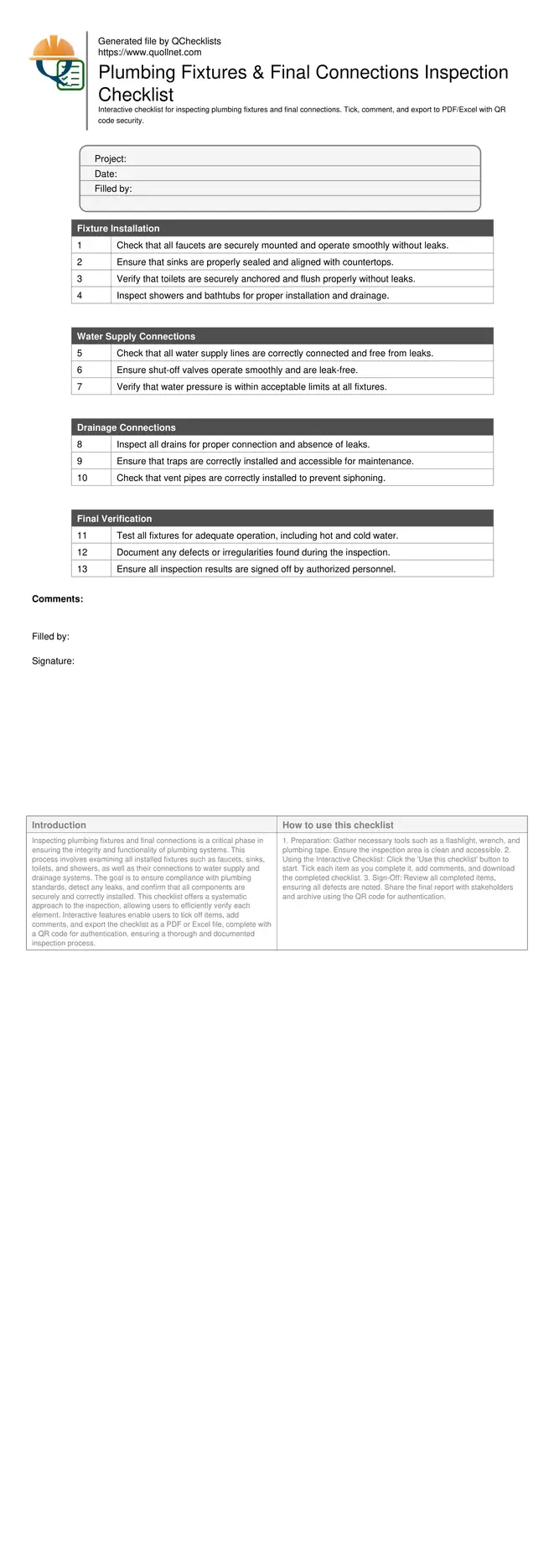Comprehensive Plumbing Inspection Checklist
Inspecting plumbing fixtures and final connections is a critical phase in ensuring the integrity and functionality of plumbing systems. This process involves examining all installed fixtures such as faucets, sinks, toilets, and showers, as well as their connections to water supply and drainage systems. The goal is to ensure compliance with plumbing standards, detect any leaks, and confirm that all components are securely and correctly installed. This checklist offers a systematic approach to the inspection, allowing users to efficiently verify each element. Interactive features enable users to tick off items, add comments, and export the checklist as a PDF or Excel file, complete with a QR code for authentication, ensuring a thorough and documented inspection process.
- Ensure all plumbing fixtures are installed correctly and securely, preventing leaks and future issues.
- Verify compliance with plumbing standards for safety and efficiency.
- Interactive online checklist with tick, comment, and export features secured by QR code.
- Efficiently document and share inspection results with stakeholders.
Fixture Installation
Water Supply Connections
Drainage Connections
Final Verification
The Importance of Fixture Inspection
Fixtures are the most visible components of plumbing systems, and their proper inspection is crucial to avoid costly repairs and ensure user satisfaction. This phase involves checking the installation integrity, alignment, and operability of faucets, sinks, toilets, and showers. Proper inspection prevents leaks and ensures the longevity of the plumbing system.
- Check for solid mounting and leak-free operation.
- Ensure proper sealing and alignment.
- Verify secure anchoring and proper flushing of toilets.
Ensuring Secure Connections
Water supply and drainage connections are vital for the seamless operation of plumbing systems. This involves checking for secure, leak-free connections and proper water pressure. Valves should operate smoothly, and drains must be connected correctly to prevent leaks and ensure adequate drainage.
- Check all supply lines for leaks.
- Verify smooth operation of shut-off valves.
- Ensure proper connection and absence of leaks in drains.
How to Use This Plumbing Inspection Checklist
- Preparation: Gather necessary tools such as a flashlight, wrench, and plumbing tape. Ensure the inspection area is clean and accessible.
- Using the Interactive Checklist: Click the 'Use this checklist' button to start. Tick each item as you complete it, add comments, and download the completed checklist.
- Sign-Off: Review all completed items, ensuring all defects are noted. Share the final report with stakeholders and archive using the QR code for authentication.
Call to Action
- Start Checklist Tick off tasks, leave comments on items or the whole form, and export your completed report to PDF or Excel—with a built-in QR code for authenticity.
- Download Excel - Plumbing Fixtures and Final Connections Inspection
- Download PDF - Plumbing Fixtures and Final Connections Inspection
- View Image - Plumbing Fixtures and Final Connections Inspection

